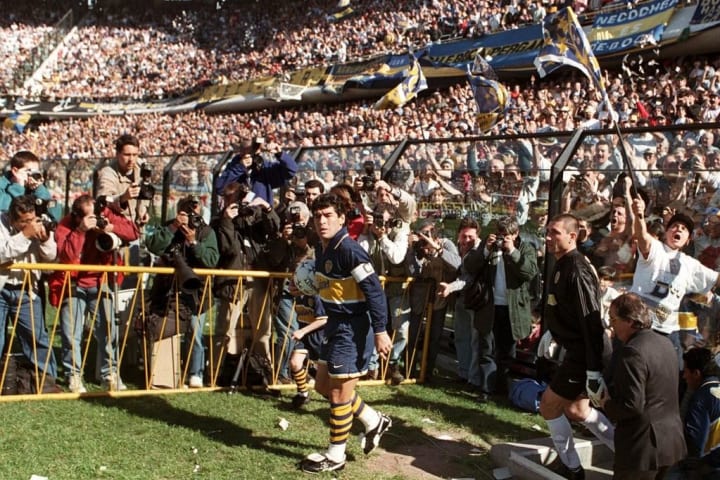
Diego Maradona: A career in images
The most gifted footballer of all time.
The most important footballer of all time.
The greatest footballer of all time.
Diego Armando Maradona ?
Remembering 10 ?????????? moments from the ?????? number 10, a year on from his death… pic.twitter.com/9ujF2o7zbx
— 90min (@90min_Football) November 25, 2021
That’s what Diego Armando Maradona was, and will always be. And while we mourn the loss of a true footballing hero, we should also celebrate his life, career, and how he single-handedly uplifted a city (Naples) and a country (Argentina) with his mercurial talents.
So in order to do so, here is the incomparable Maradona’s footballing career, in pictures:
#DíaComoHoy en 1976, Diego Maradona debutó en primera división del fútbol argentino con Argentinos Juniors. pic.twitter.com/2skaT8tbiW
— ElPrope EINSTEIN (@ElpropeEINSTEIN) October 20, 2017
„They say people witness at least one miracle in their lives, but most do not even realise. I certainly did. My miracle occurred on that rainy Saturday in 1969, when an eight-year-old kid, an age I could not believe, did things with the ball that I’d never seen in my life.“
That’s what Francis Cornejo – the youth coach who discovered Maradona – said of an eight-year-old Diego the first time he saw him in action.
Seven or so years later he would make his debut for Argentino Juniors and become the youngest player in Argentinian top flight history.
After showcasing his burgeoning talents during a remarkably goal-laden five years at Argentino Juniors, the country’s biggest club – Boca Juniors – came calling.
28 goals, 40 games and a league title later, he was a Boca icon.
My dad was at Hampden to see Diego Armando Maradona make his Argentina debut and he talks about it constantly. The King has left us. The greatest ever. The talent, the character, everything about him. A once in a lifetime human being. Muchas gracias, Diego. Feliz viaje, Señor
❤️ pic.twitter.com/BCnrEkWYCU— Mark Hannah (@markthannah) November 25, 2020
„Scotland Reel to Maradona Magic!“
Yep, that’s right, Diego Maradona’s Argentina debut came against Scotland. At just 18 years old, he scored in Argentina’s 3-1 win at a packed Hamden Park.
Heading into his first World Cup in 1982, it’s fair to say that a lot was expect of Maradona.
A LOT.
But, unlike the 1986 World Cup, things didn’t really go to plan. El Diego was battered and bruised by Italy’s Claudio Gentile, he saw red in a 3-0 defeat at the hands of Brazil, and Argentina went home from Spain with their tail firmly between their legs…

…Well, most of the team would. Maradona would opt to stay in Spain, signing for Barcelona in a then-world record deal.
El Alcalde de Nápoles anunció que el Estadio San Paolo pasará a llamarse Diego Armando Maradona https://t.co/eUrckVPNS6 pic.twitter.com/Q9MXaKXlIK
— C5N (@C5N) November 25, 2020
For a myriad of reasons – which we don’t really need to get into – Maradona at Barcelona just didn’t, well, fit.
After two injury ravaged seasons at Barcelona, El Diego would up and leave for SSC Napoli; a then-mid-table Serie A club.
It was surprising move, but it would turn out to be the best of his career.
Maradona would take the Napoli to new heights, giving the southern city their first ever Scudetto during the 1986/87 season.
“I knew it was my hand. It wasn’t my plan but the action happened so fast that the linesman didn’t see me putting my hand in. The referee looked at me and he said: ‘Goal.’
“It was a nice feeling like some sort of symbolic revenge against the English.”
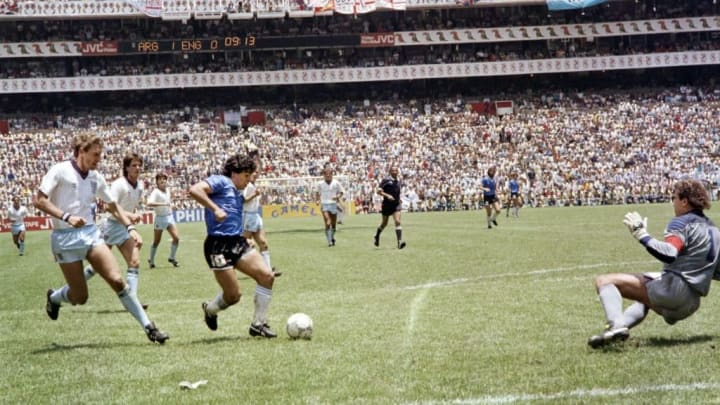
Five minutes after punching the ball into the net, as some sort of penance, Maradona repaid the footballing world with the most electric, spellbinding, downright perfect goal in the history of the sport.
Diego Maradona verses Belgium in the 1982 World Cup. This picture always mesmerised me. #Rip ? pic.twitter.com/MFE2ePT9Ns
— Chris Wright ??????? (@chriswrightzz) November 25, 2020
Despite being man-marked by the whole Belgian national team in the semi of the World Cup, Maradona still managed to bag a brace.
On 29th June 1986, Maradona received his just rewards for the greatest single tournament performance in footballing history – lifting the World Cup trophy after beating West Germany 3-2 in the final at Azteca Stadium.
A Scudetto was unthinkable at Napoli – a European trophy was even more unthinkable.
And yet, Maradona delivered one in 1989.
Christ, what a kit.
Maradona ensured that Napoli remained a force the season after winning the UEFA Cup by winning another Scudetto.
To put this into context: Napoli haven’t won a single league title since.
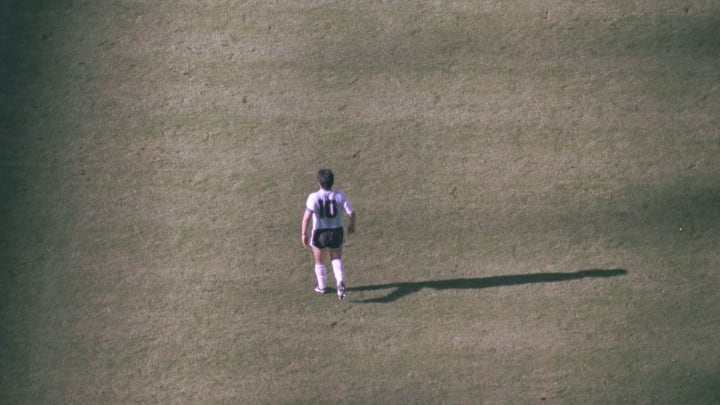
Yes small, but also far away.
Ahead of the 1990 World Cup semi final between home nation Italy and tournament favourites Argentina in Naples, Maradona called on Neapolitans to support his team instead of the Azzurri.
They didn’t (for the most part), but Argentina still won and made their second consecutive World Cup final.
„He is the best rival I’ve ever had. I guess that’s enough to define him.“
That’s what Diego Maradona said about Lothar Matthaus – the man who expertly man-marked him the the 1990 World Cup final.
Maradona’s return to La Liga wasn’t particularly successful, but he did grow perhaps the greatest mullet of all time, so who cares?
Se Maradona tivesse ido para o Newell’s Old Boys seis meses antes, ele teria enfrentado o São Paulo pela Libertadores de 1993. ? El Grafico pic.twitter.com/3abLdhy2f2
— Alexandre Giesbrecht (@jogosspfc) November 25, 2020
How brief you ask? Five games.
Maradona arrived at the 1994 World Cup in the best shape he’d been in since the previous World Cup four years prior. And he started the tournament off like a house on fire, scoring a wonderful goal against Greece…
…However things quickly unravelled when Maradona tested positive for a banned substance and was sent home after two games.
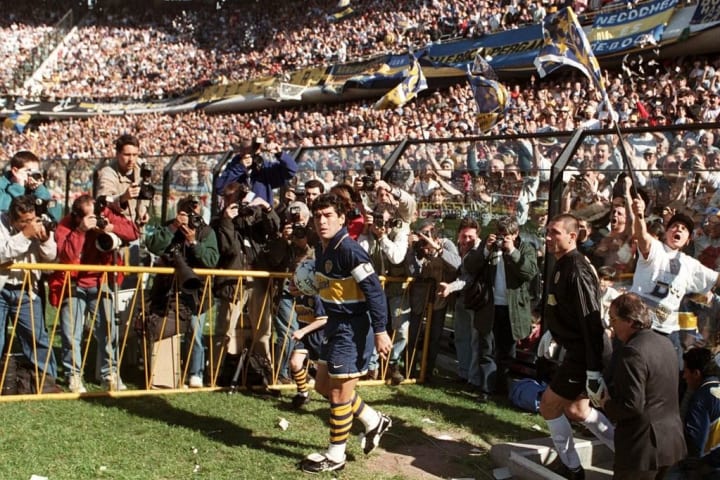
Thankfully our last image of Maradona, the footballer, wasn’t to be his World Cup debacle. Rather, it was his three joyous seasons at Boca Juniors, where – despite not playing too often – El Diego was hailed as, well, what he was:
A footballing icon.
A banner hung on a graveyard in Naples after el Diego delivered them their first ever league title. pic.twitter.com/Esc4l0F0fw
— tehTrunk (@tehTrunk) November 25, 2020